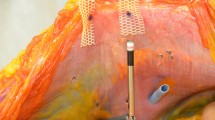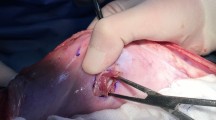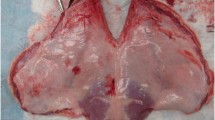Abstract
Background
A variety of permanent and absorbable tacks are available for mesh fixation during laparoscopic hernia repairs. Although manufacturers recommend deploying tacks perpendicular to the tissue, achieving this can sometimes be challenging. This study aimed to analyze comparatively the effects of angled deployment among commonly used tacks.
Methods
A piece of composite mesh was fixed to the peritoneal surface of a pig with a single tack fired at either a perpendicular (90°) or acute (30°) angle. A lap-shear test was performed to determine fixation strength. Two permanent tacks (a titanium spiral tack: Protack [PT]; and a hollow screw fastener: PermaFix [PF]) and three absorbable tackers (a solid screw: Absorbatack [AT]; a hollow screw fastener: SorbaFix [SF]; and a strap: SecurStrap [SS]) were challenged. A total of 16 samples were performed for each device at each angle. A nonabsorbable transfascial suture was used as a control condition.
Results
Transabdominal sutures had the maximum acute tensile strength (ATS) (29.9 ± 5.5 N). Protack at both 90° and 30° performed significantly better than absorbable tacks (p < 0.01). No significant difference was found among absorbable tacks at 90°. When the same construct was compared at different angles, SS and SF performance was not affected (p = 0.07 and 0.2, respectively). In contrast, PT and AT had significantly reduced fixation strength (p = 0.003 and 0.004, respectively). However, PT fired at an acute angle had fixation equal to that of absorbable tacks fired perpendicularly.
Conclusion
Transabdominal sutures performed better than tacks in the acute setting. No absorbable fixation device demonstrated superior efficacy within its class. Spiral titanium tacks provided better fixation than absorbable tacks at both perpendicular and acute angles. Moreover, titanium spiral tacks deployed at 30° performed equal to or better than absorbable tacks fired perpendicularly to the tissue. It appears that spiral titanium tacks should be strongly considered for cases in which perpendicular tack deployment cannot be achieved.






Similar content being viewed by others
References
Mudge M, Hughes LE (1985) Incisional hernia: a 10 year prospective study of incidence and attitudes. Br J Surg 72:70–71
Millennium Research Group (2008) U.S. markets for soft tissue repair 2009. Millennium Research Group, Inc., Toronto
Ramshaw BJ, Esartia P, Schwab J, Mason EM, Wilson RA, Duncan TD, Miller J, Lucas GW, Promes J (1999) Comparison of laparoscopic and open ventral herniorrhaphy. Am Surg 65:827–831 (discussion 31–32)
Pierce RA, Spitler JA, Frisella MM, Matthews BD, Brunt LM (2007) Pooled data analysis of laparoscopic vs open ventral hernia repair: 14 years of patient data accrual. Surg Endosc 21:378–386
Heniford BT, Park A, Ramshaw BJ, Voeller G (2000) Laparoscopic ventral and incisional hernia repair in 407 patients. J Am Coll Surg 190:645–650
Awad ZT, Puri V, LeBlanc K, Stoppa R, Fitzgibbons RJ Jr, Igbal A, Filipi CJ (2005) Mechanisms of ventral hernia recurrence after mesh repair and a new proposed classification. J Am Coll Surg 201:132–140
LeBlanc KA (2007) Laparoscopic incisional hernia repair: are transfascial sutures necessary? A review of the literature. Surg Endosc 21:508–513
Carbonell AM, Harold KL, Mahmutovic AJ, Hassan R, Matthews BD, Kercher KW, Sing RF, Heniford BT (2003) Local injection for the treatment of suture-site pain after laparoscopic ventral hernia repair. Am Surg 69:688–691 (discussion 91–92)
Greenstein AJ, Nguyen SQ, Buch KE, Chin EH, Weber KJ, Divino CM (2008) Recurrence after laparoscopic ventral hernia repair: a prospective pilot study of suture versus tack fixation. Am Surg 74:227–231
Wassenaar E, Schoenmaeckers E, Raymakers J, van der Palen J, Rakic S (2010) Mesh-fixation method and pain and quality of life after laparoscopic ventral or incisional hernia repair: a randomized trial of three fixation techniques. Surg Endosc 24:1296–1302
Melman L, Jenkins ED, Deeken CR, Brodt MD, Brown SR, Brunt LM, Eagon JC, Frisella M, Matthews BD (2010) Evaluation of acute fixation strength for mechanical tacking devices and fibrin sealant versus polypropylene suture for laparoscopic ventral hernia repair. Surg Innov 17:285–290
Byrd JF, Agee N, Swan RZ, Lau KN, Heath JJ, Mckillop IH, Sindram D, Martinie JB, Iannitti DA (2011) Evaluation of absorbable and permanent mesh fixation devices: adhesion formation and mechanical strength. Hernia 15:553–558
Cobb W, Carbonell AM, Novitsky YW, Matthews BD (2009) Central mesh failure with lightweight mesh: a cautionary note. In: Presented at the European Hernia Society annual meeting, Berlin, Germany, 2009
Lerdsirisopon S, Frisella MM, Matthews BD, Deeken CR (2011) Biomechanical evaluation of potential damage to hernia repair materials due to fixation with helical titanium tacks. Surg Endosc 25:3890–3897
Cobb WS, Burns JM, Kercher KW, Matthews BD, Norton HJ, Heniford BT (2005) Normal intraabdominal pressure in healthy adults. J Surg Res 129:231–235
Heniford BT, Park A, Ramshaw BJ, Voeller G (2003) Laparoscopic repair of ventral hernias: nine years’ experience with 850 consecutive hernias. Ann Surg 238:391–399
Sugerman H, Windsor A, Bessos M, Wolfe L (1997) Intraabdominal pressure, sagittal abdominal diameter, and obesity comorbidity. J Intern Med 241:71–79
Majercik S, Tsikitis V, Iannitti DA (2006) Strength of tissue attachment to mesh after ventral hernia repair with synthetic composite mesh in a porcine model. Surg Endosc 20:1671–1674
Reynvoet E, Berrevoet F, De Somer F, Vercauteren G, Vonoverbeke I, Chiers K, Troisi R (2012) Tensile strength testing for resorbable mesh fixation systems in laparoscopic ventral hernia repair. Surg Endosc. doi:10.1007/s00464-012-2224-4
Disclosures
Yuri W. Novitsky is a speaker for Lifecell and Davol and serves as a Consultant for Davol and Kensey Nash. Michael J. Rosen is a Speaker for Lifecell, and receives research support from Lifecell, Davol, W. I. Gore, and Cook. Emmanuel E. Sadava, David M. Krpata, Yue Gao, and Steve Schomisch have no conflicts of interest or financial ties to declare.
Author information
Authors and Affiliations
Corresponding author
Rights and permissions
About this article
Cite this article
Sadava, E.E., Krpata, D.M., Gao, Y. et al. Laparoscopic mechanical fixation devices: does firing angle matter?. Surg Endosc 27, 2076–2081 (2013). https://doi.org/10.1007/s00464-012-2713-6
Received:
Accepted:
Published:
Issue Date:
DOI: https://doi.org/10.1007/s00464-012-2713-6




